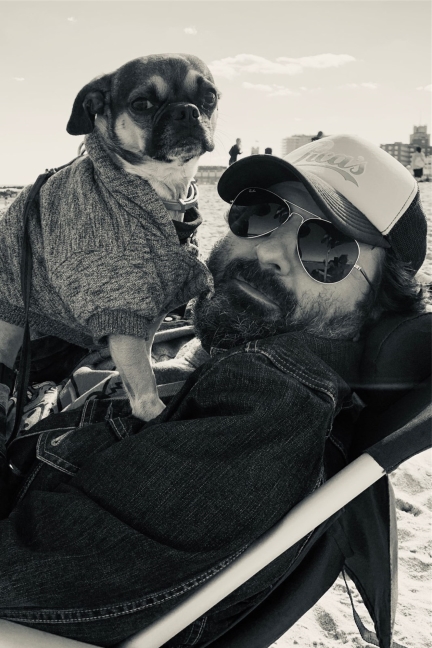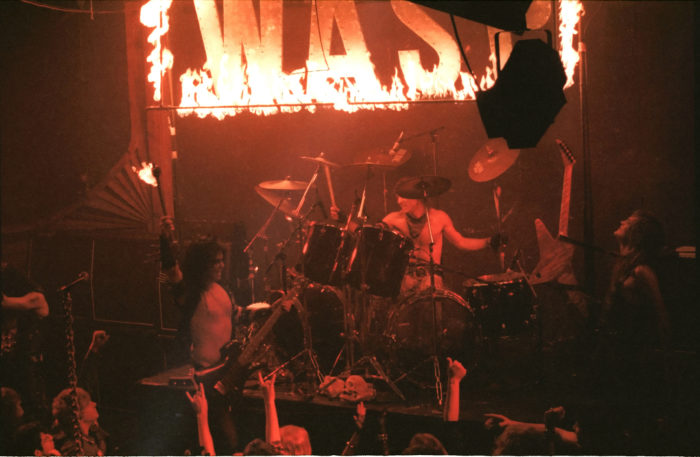by Tom Beaujour and Richard Bienstock
Hard rock in the 1980s was a hedonistic and often intensely creative wellspring of escapism that perfectly encapsulated—and maybe even helped to define—a spectacularly over-the-top decade. The following photos reflect some of the most iconic bands and moments of a generation that was looking for nothin’ but a good time…and found it.
Motley Crue
Motley Crue at their first-ever photo shoot in 1981. From the clothes to the hair to the sound, the band would soon remake the Sunset Strip in their image. “I did a shoot with them where it was something like an 11-hour day,” recalls photographer Don Adkins of those early sessions, “and I think nine hours of that was hair. It was a really elaborate procedure.”
Stryper in their rehearsal loft

In 1984 Bill and Wes Hein, co-owners of Enigma Records, went to see Stryper showcase at their loft in Southern California when they were considering signing the band. “They came out and everything was striped,” says Wes Hein. “All their equipment. Every guitar, all the drums. I think their girlfriends and moms had made their outfits. It was probably just yellow clothes and black electric tape.”
“We thought it was nuts,” Says Bill Hein. “But you have to remember—at that point nuts to us was good.”
W.A.S.P. onstage at the Troubadour
In the early ‘80s, attending a W.A.S.P. show at the tiny Troubadour club in L.A. could feel like you were putting your life in their raw-meat-throwing hands. “I remember the skin on my face was just boiling,” says photographer Kevin Estrada, who took this shot. “It felt like it was going to peel off because that place was so damn hot.”
Quiet Riot
Quiet Riot had been kicking around in different incarnations for almost a decade before breaking down the doors for glam metal to enter the mainstream. Much of this was due to the success of “Cum on the Feel the Noize,” which became a huge MTV hit and led the accompanying album, Metal Health, to be the first metal record to top the Billboard album chart. For bands like us that were colorful and had a lot of personality, MTV was the perfect tool,” says Quiet Riot bassist Rudy Sarzo.
Twisted Sister
MTV could also be a double-edged sword. New York’s Twisted Sister are shown here on their set of their video for “I Wanna Rock,” one of the biggest and most-played clips of 1985. It helped to make the band – and in particular lead singer Dee Snider – household names and images, but at a cost. “I remember getting a fan letter saying ‘My favorite bands are Kajagoogoo, Duran Duran and Twisted Sister,” recalls Snider. “And I was like, ‘Ruh-roh.’ That was a moment where we said, ‘This is wrong. These three names shouldn’t be on the tongue of this fourteen-year-old girl.’ I was not ready for that.”
Poison
A rare early shot of Poison backstage at Hollywood’s Roxy, with original guitarist Matt Smith. The band had recently relocated from Pennsylvania, packing everything they owned in a van and driving across the country until they hit the Sunset Strip. “We had a kind of naïve belief in ourselves and in what we wanted the band to be: a combination of the glam look and the party sound,” says singer Bret Michaels. “We thought music kind of sucked. It had no energy. We did have the energy and we just wanted to be rock stars, man.”

Tom Beaujour is a journalist and co-founder and former editor-in-chief of Revolver, America’s premier hard rock and heavy metal monthly. Beaujour has produced and mixed albums by Nada Surf, Guided by Voices, the Juliana Hatfield Three, and many others.

Richard Bienstock is a journalist whose writing has appeared in the New York Times, Rolling Stone, Billboard, Spin, and other publications. He is a former senior editor of Guitar World magazine and executive editor of Guitar Aficionado magazine. He has authored and co-authored several books, among them Kurt Cobain: Montage of Heck.





